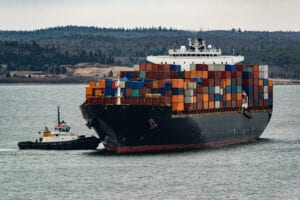The recent week-long blockage of the Suez Canal by the massive container ship Ever Given served as the latest reminder that industrial businesses, and their supply chains, need to accelerate their digital transformation initiatives. According to the German insurer Alliance, the blockage held up an estimated $400 million USD per hour in international trade. The Ever Given isn’t the first ship to stop traffic through the canal. In 2004, the oil tanker Tropic Brilliance was stuck for three days and needed to be refloated. Sadly, having previously lived through a near identical disaster, it seems that the industrial world was no better able to respond to this “extreme” event the second time around.
Despite the uptick of catastrophic events such as the current pandemic, hurricanes, floods, and wildfires, most industrial organizations remain paralyzed when the unexpected occurs. Their siloed internal systems lack the holistic visibility and agility needed to quickly adapt when rapid, unforeseen marketplace shifts occur.

The reason most businesses are siloed is historic. Silos were developed as a culture over the years before modern approaches such as Industry 4.0 and digitization existed. The tradition has been to focus employees on actions and efforts geared towards silo-oriented KPIs. Those within the organization who wanted to push for change towards a more horizontal integration had difficulties accomplishing this transformation because of technological limits. Implementing such changes was simply too expensive.
Digital transformation breaks down traditional silos
However, all of that has changed as industrial businesses no longer need to operate in a vertical or hierarchical fashion. In smart factory environments, for example, new ways of working are emerging. Software for lean manufacturing and production optimization can now aggregate data and information across plant operations and even upstream and downstream supply chains. This allows for global visualization of the factors impacting plant performance. This also enables operations to become more predictive than reactive and supports operational decision-making with live tracking of production line performance combined with digitized lean manufacturing best practices.
How people interact and work together is totally different than before. Start-up organizations seem particularly adept at adopting and scaling this vision of horizontal integration than most traditional companies.
Schneider Electric, for example, is introducing the concept of smart logistics into its own distribution centers and into the operations of some of its key logistics customers. The use of big data analytics and service-level dashboards are helping many of these organizations to gain better visibility into their transactional workflows. This ability then acts as a catalyst to help them expand to more complex areas of logistics such as omnichannel fulfillment (using digital platforms to support orders from the many different purchasing channels including online shopping carts, storefronts, or specialty marketplaces).
Organizations, like Schneider Electric and Amazon, have recognized that holistic, organization-wide visibility is now possible through digital transformation. Amazon has succeeded in establishing digital-driven operations that link supply chain to warehouses, to delivery vans, to airplanes, and to cloud data centers. All their important data and information is available from one interface, and, just as important, their technology infrastructure is easily scalable. In this connected, agile world where holistic integration makes real-time visibility possible, the agile get richer while the siloed organizations get poorer. Competitive advantage expands exponentially as flexible systems can adapt to rapid changes.
Looking back on our earlier example of the Suez Canal blockage event, it’s almost impossible to grasp the fact that the Ever Given carried 28,000 containers. That’s more containers on that one ship than the number of people who can fit into New York’s Madison Square Garden for a sports event or rock concert. One of the many implications of the blockage of such a volume of containers (including ships waiting in line behind the Ever Given) is that producers in China are constrained in their delivery of goods because they face a shortage of empty containers in which to ship their goods. At the same time, manufacturing sites in Europe and the Americans are not receiving the goods and raw materials they need for production.
A holistic view of operations can lower cost and boost efficiency
In a digital world, shipping companies, for example, who wish to differentiate themselves, can use digital transformation to acquire a total understanding of where their containers are, full or empty, at anytime, anywhere across the globe. Then, by gathering and centralizing all that status data, they can employ smarter tactics and strategies by factoring in variables such as seasons, weather, political events, and unanticipated business disruptions.
The ability to think holistically allows company stakeholders to visualize a process that minimizes the number of movements a container must make during its journey from supplier to consumer. If a container must be moved seven times, when only three movements could be required, each additional movement represents additional energy consumption and potential waste of resources. Holistic views fueled by data that accounts for container movement history and behavioral patterns, as well as the possibility of an unanticipated event, results in a recognition of the most efficient life cycle of that container.
Such an example applies to any industry that desires to go beyond siloed efforts of process optimization, and solitary digitization efforts that move no further than the pilot stage. Like Amazon, companies must allow themselves a vision that incorporates the critical stage of scaling their processes to reap the exponential benefits of digitization.
The ability to better predict the shortages in a particular factory, for example, will offer opportunities to compensate with alternative approaches ahead of time, before customer satisfaction and supply chain efficiencies are impacted.
A new approach for moving towards holistic transformation
The ability to evolve beyond silos and greatly expand operational visibility requires a disciplined migration approach that integrates digital transformation in a holistic manner. Offerings such as Schneider Electric’s Transformation Consulting Services provide a roadmap that helps clients successfully navigate such transitions. Ambitions workshops identify long-range goals and help to measure potential business impact and ROI of modernization initiatives. Techniques such as design thinking and predictive models are used to overcome perceived traditional barriers. The philosophy focuses on using digital transformation to create exceptional experiences for targeted corporate customer personas. Digital maturity is also benchmarked to determine overall competitiveness, and blueprints are created that document the steps needed to achieve the desired success.
Schneider Electric can further support these consulting efforts by offering solutions that digitize factory and supply chain operations. Solutions such as predictive maintenance, and digital twin virtual modeling help in building more resilient businesses. Here is a list of relevant materials.
- Predictive Maintenance Solutions
- ProDiagTM diagnostic tools
- Smart Manufacturing Solutions
- EcoStruxure solutions for industry
- Digital Twin eGuide
- Blog: How Power Analytics can Benefits from Digital Twins
To learn more about how your company can embark on a journey that embraces true digital transformation, read our blog series and contact Rik De Smet.
CNN Indonesia published a Digital Transformation article co-authored by Rik and Farid Belbouab, CEO of shipping company Meratus. Read the English version here.



